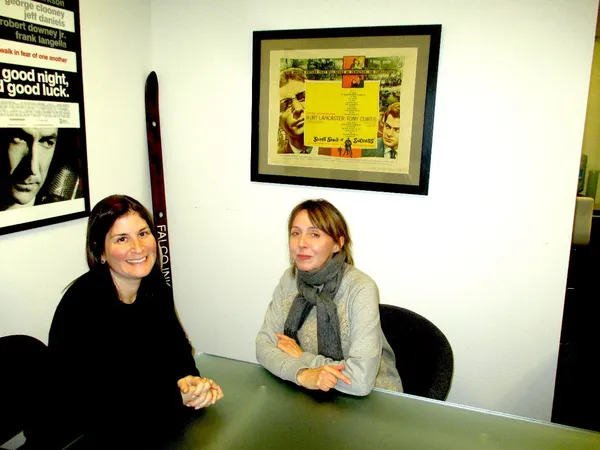 |
| Swim Team director Lara Stolman with Anne-Katrin Titze: "I wanted to be able to go deep in this film." Photo: Monica Delamater |
On the closing night of DOC NYC, an exceptional documentary on what it means to come together for a common goal under extraordinary circumstances will be shown. Swim Team captures individual members of the Jersey Hammerheads, co-founded by Mike and Maria McQuay, as they form a bond in and out of the water while training in the hope of qualifying for the Special Olympics.
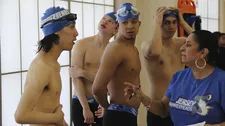 |
| Jersey Hammerheads - Maria McQuay guides Kelvin with Robbie, Mike and Hayden |
Shot by Laela Kilbourn (Morgan Neville's Oscar-winning 20 Feet From Stardom), edited by co-producer Ann Collins (Josh Aronson's Oscar-nominated Sound And Fury) with a score by Mark Suozzo (Whit Stillman's Damsels In Distress, The Last Days Of Disco, Barcelona, Metropolitan), produced by Shanna Belott, Lara Stolman has assembled an impressive team of her own as her film enters the lives of the families of the young competitors showing us the challenges they face every day.
Lara joined me for a conversation which took us through the decisions, research and concerns she had in the development of Swim Team, one of the highlights of DOC NYC 2016. The McQuays' son Mikey, as well as teammates Kelvin, Robbie and Hayden are teenagers from New Jersey on the autism spectrum.
Anne-Katrin Titze: Let's jump right in. "Swimming works better than medication" is a sentence, I believe, Kelvin's father [Stanley Truong] says in the film. Isn't this at the center of your film? One of the core lines?
Lara Stolman: Yeah, yeah, it is. You know, it's interesting, I just came back from the Napa Valley Film Festival and we had four screenings there. We had the opportunity to do Q&As after the films which is the great thing about film festivals - people can talk and we can hear stories from people in the audience. And that's always a discussion. Doctors want to speak about this actually, who have seen the film and people who are also connected to teaching and swimming. It's something that hasn't been studied enough, I think, in the science.
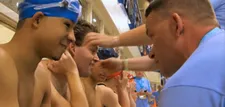 |
| Mike McQuay coaching the Jersey Hammerheads |
There actually is a study out of Taiwan about the therapeutic value of swimming for people on the [autism] spectrum. But I think it was only one study I was able to find. It would be great if there was more research because there's so much anecdotal evidence. There is my film and all of the families told me that their kids loved being in the water. They loved even being in the shower. It wasn't just plunging into a pool, it was water in general that all these kids had in common.
AKT: A sense of safety? The fact that water encompasses us? It never crossed my mind before until I saw your film that connected autism and swimming. Your three protagonists [Mikey, Robbie, Kelvin] are wonderful. How difficult was it to make the decision to focus on these three?
LS: It was so hard to focus on three of them. I love the three of them. There were 17 kids on the team and I loved all of them and they were all really interesting. There's one boy who had a lot of difficulty speaking and his father said to me in an interview, "he can't speak, but he can express himself through the language of music." He plays piano and he plays like a virtuoso. I filmed him playing and I wanted so badly for him to be one of the main characters but it didn't work with the others.
There are a number of reasons why these three work so well together and one of them is they are on a relay team and from a story standpoint they had to be together. And they became friends and they are so different. They each have their own difficulties with social interaction and the relay team forced them actually to figure out how to interact.
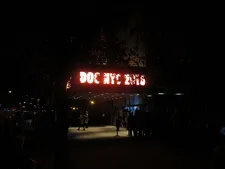 |
| DOC NYC 2016 at the SVA Theatre Photo: Anne-Katrin Titze |
They were the best swimmers also on the team, I was drawn to - I can't lie. I thought it was fascinating if you just saw them swim, you'd have no idea that they had any struggle at all out of the water. There is such a contrast. And they were going through these transition years.
AKT: Can you explain?
LS: Transition is when your child has an IEP [Individualised Education Program], has a disability, in the United States, the school district can provide services until age 21 and then the family really has to figure out what to do. There isn't the same level of support from the government. Some people say it's like falling off a cliff because you lose support and it's hard to find support. I thought it was an important conversation to be having.
AKT: You have it in the film. What happens to them now? You follow a lovely line with the animal drawings, the classifications of the animal drawings going to stuffed animals and then ending up with the goats - I don't want to give away too much. Did you see that in the editing process or was it planned as a structure from the beginning?
LS: Thank you so much for appreciating that. That's a result of shooting a lot of material in the field but noticing all of the animal connections. He loves animals.
AKT: Mikey that is.
LS: Yeah. Like in his room he has posters of animals and he has a collection of DVDs, all animal movies. His whole life he has been obsessed with animals. We couldn't not make that part of the story getting to know him. But all of those connections you see in the film are also related to the symptoms of autism. Like the lining up of animals, and the categorization, and naming them. It was very deliberate the way it happens in the film but it's so true to him and his life. In fact there were more things that we could have put in.
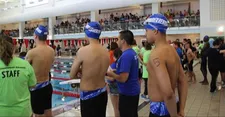 |
| "They each have their own difficulties with social interaction and the relay team forced them actually to figure out how to interact." |
AKT: Early on, he introduces himself that way - he says something along the lines of - Underwater, I am like a fish and then I come up like a dolphin and I'm like a whale. Another moment I really liked was when Robbie is reading the T-shirt. He calls them "The Hammer - Shark - Heads". You don't at first show us what he is seeing. I imagined that he was reading the word "Hammer", sees the picture of a shark, and reads "Heads". Is that it?
LS: I definitely wanted the audience to know right away that he is not a typical kid. With these kids in particular, you wouldn't necessarily know just by looking at them, the extent of their disability. With Robbie, you need to listen to the way he communicates. And this is a perfect example of the difficulty he has with communication, with reading, with using language.
It's funny, a moment later [Jersey Hammerheads co-founder] Maria [McQuay] says " You earned your leather jacket." And he says "400 Dollars." Whenever I see the film playing in a theater, everyone laughs at that. It is funny but he really doesn't understand that she means earned in a different way. That's part of his disability - is the language.
AKT: But by that he is pointing us to our use of language.
LS: Right, right.
AKT: Which I think is a fascinating other level here. How do we - in so-called normal communication, whatever that may be - deal with language? That's part of the laughter, maybe? I felt that the parents must have trusted you so much. One hardly ever sees such openness. How did that come about? How did you get them to open up so much?
LS: Thank you. Well, I am the mother of a son with autism. I think that had a lot to do with it. I have three children but I have a son on the spectrum.
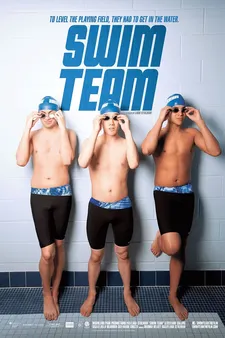 |
| Swim Team poster |
AKT: He is not on the team?
LS: No. I'm not in the film and my son is not in the film. But certainly my experience is reflected, I think, in the storytelling, in the intimacy that I think those scenes show. We had so much in common and I think they all felt comfortable with me right away because of that. It's not something I talk about a lot. It's about me in the sense that because it's my life raising a child with autism, I've become an expert on a lot of things related to autism.
I did a tremendous amount of research about autism intervention, autism education, autism policy, even autism history. My approach to the film definitely reflects all of that experience.
AKT: It explains why Robbie's mother [Rosa Justino] opens up to you about not having had "the talk", that he is not aware that he has autism. Were you hesitant about putting it in the film or not?
LS: I thought it was very important that it was part of the film. As soon as she explained to me why he was on that team - he was on two other teams, his high school team, he was on an elite swim team, he didn't need to be on this third team - but she was very specific with her reasons. She wanted help in telling him. She thought it would be easier for her to have that talk. I said to her, "you know, he's going to find out with this film, if you don't tell him! If you'd like, I could help you."
And I asked her if it was okay if I filmed it and I also felt that it was very important that she did it, knowing how old he was. That he was spending more and more time without his family in the world and that he needed to be able to advocate for himself. He needed to be able to communicate with people who didn't know him and say say this is who I am. I think about this with my own child. I think about the importance.
AKT: How old is your son?
LS: He is only ten at this point. Kelvin's dad at the end of the film he says "We have to do what we can to help him be as independent as possible and cope with his disability." And I think that's a concern for all parents in our situation. That conversation was important in that respect. I'm happy that I was able to help her with it.
_225.webp) |
| The Suskind family of Life, Animated with Perri Peltz Photo: Anne-Katrin Titze |
AKT: And she saw it and is happy?
LS: Very happy! Everybody saw it. They all saw the film. We had a screening at Autism New Jersey a few weeks ago and they all loved it. And they'll all be in New York on Thursday. It'll be special.
AKT: All of them?
LS: Yes, we didn't know for sure if Kelvin was going to because his parents were a little nervous about bringing him. But he's going to come.
AKT: What about Hayden and his parents?
LS: I wanted to include him as a main character and the problem is we only have a certain amount of time. I wanted to be able to go deep in this film. I felt it would compromise that experience to add an additional character. We get him in as much as we can. He is really great. You can't have a film with six or seven characters and have it be as deep.
AKT: Did you see [Roger Ross William's] Life, Animated [DOC NYC Short List]?
LS: Not yet.
AKT: What is Mikey's father's real job?
LS: He is a contractor.
AKT: He is a great coach. You don't go at all into the families' backgrounds. It must have been one of your greatest problems - what to leave out?
 |
| Lara Stolman: "I did some of the shooting underwater too. That was a lot of fun - figuring out how to do that, how to use it." Photo: Anne-Katrin Titze |
LS: He has an athletic background, though. I wasn't sure how much to go into that. But he was a football player, he played every sport. He was one of those guys that played a lot of sports and all the sports he played, he played well.
AKT: It shows in how he deals with his team. Your cinematographer …
LS: Laela [Kilbourn]! This was an all-female creative team, by the way.
AKT: Oh, good!
LS: My editor/co-producer woman [Ann Collins], my DP woman, I'm a woman.
AKT: She was involved with 20 Feet From Stardom, no?
LS: She was one of the cinematographers on that. She also filmed How to Dance in Ohio, which was at Sundance a couple of years ago. I wanted to work with Laela after I saw a film she made called Sync or Swim, which was about a synchronized swimming team. I needed somebody I knew who would get in the water.
AKT: Are you a swimmer?
LS: Yes. So I did some of the shooting underwater too. That was a lot of fun - figuring out how to do that, how to use it. It was tough. At first I was worried because we are all used to seeing gorgeous, expensive underwater photography now because of the Olympics. I looked into all kind of devices like building a platform in the pool or hiring professional underwater photographers. Laela is not an underwater photographer per se. She is a DP, her specialty is cinéma vérité. That was our first priority and then we figured out the underwater and I think we did it pretty well.
AKT: Yes, you did. Absolutely.
DOC NYC screenings: Thursday, November 17 at 7:30pm - SVA Theatre; Thursday, November 17 at 9:55pm - SVA Theatre; Expected to attend: Lara Stolman, subjects Mike and Maria McQuay with their son Mike, Jr., Rosa Justino with her son Robbie, Kelvin, producer Shanna Belott, co-producer/editor Ann Collins
DOC NYC runs through November 17.





















